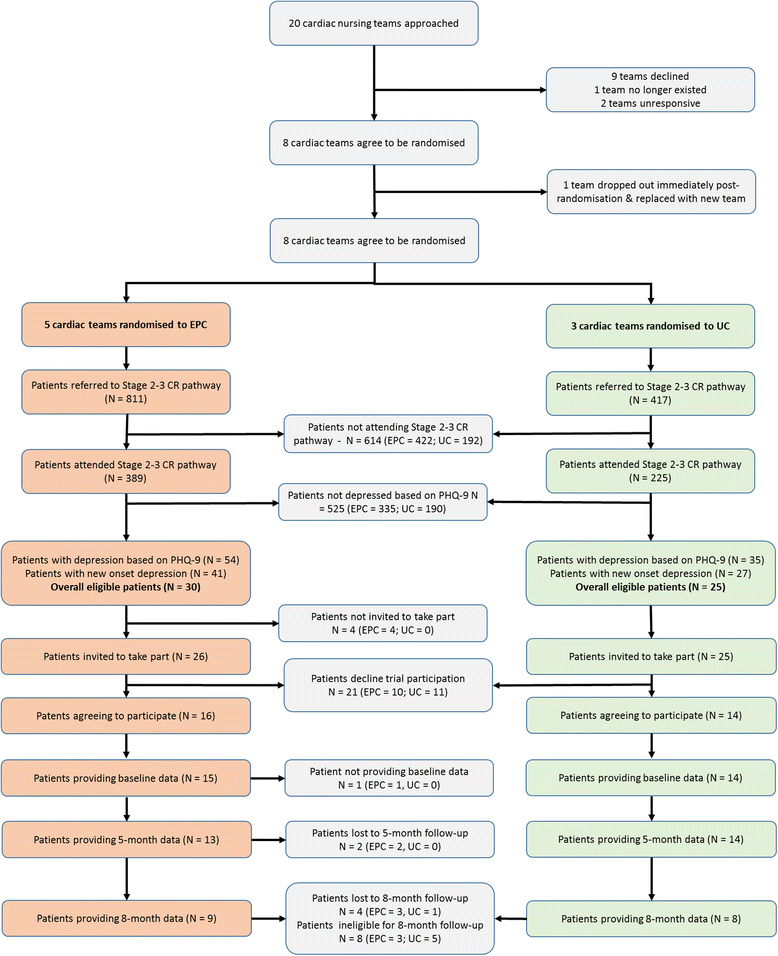Assessing the effectiveness of Enhanced Psychological Care for patients with depressive symptoms attending cardiac rehabilitation compared with treatment as usual (CADENCE): a pilot cluster randomised controlled trial
- PMID: 29609644
- PMCID: PMC5880097
- DOI: 10.1186/s13063-018-2576-9
Assessing the effectiveness of Enhanced Psychological Care for patients with depressive symptoms attending cardiac rehabilitation compared with treatment as usual (CADENCE): a pilot cluster randomised controlled trial
Abstract
Background: Around 17% of people attending UK cardiac rehabilitation programmes have depression. Optimising psychological wellbeing is a rehabilitation goal, but provision of psychological care is limited. We developed and piloted an Enhanced Psychological Care (EPC) intervention embedded within cardiac rehabilitation, aiming to test key areas of uncertainty to inform the design of a definitive randomised controlled trial (RCT) and economic evaluation.
Methods: An external pilot randomised controlled trial (RCT) randomised eight cardiac rehabilitation teams (clusters) to either usual care of cardiac rehabilitation provision (UC), or EPC in addition to UC. EPC comprised mental health care coordination and patient-led behavioural activation with nurse support. Adults eligible for cardiac rehabilitation following an acute coronary syndrome and identified with new-onset depressive symptoms during an initial nurse assessment were eligible. Measures were performed at baseline and 5- and 8-month follow-ups and compared between EPC and UC. Team and participant recruitment and retention rates, and participant outcomes (clinical events, depression, anxiety, health-related quality of life, patient experiences, and resource use) were assessed.
Results: Eight out of twenty teams were recruited and randomised. Of 614 patients screened, 55 were eligible and 29 took part (5%, 95% CI 3 to 7% of those screened), with 15 patient participants cluster randomised to EPC and 14 to UC. Nurse records revealed that 8/15 participants received the maximum number of EPC sessions offered; and 4/15 received no sessions. Seven out of fifteen EPC participants were referred to another NHS psychological service compared to none in UC. We followed up 27/29 participants at 5 months and 17/21 at 8 months. The mean difference (EPC minus UC) in depressive symptoms (Beck Depression Inventory) at follow-up (adjusting for baseline score) was 1.7 (95% CI - 3.8 to 7.3; N = 26) at 5 months and 4.4 (95% CI - 1.4 to 10.2; N = 17) at 8 months.
Discussion: While valued by patients and nurses, organisational and workload constraints are significant barriers to EPC implementation. There remains a need to develop and test new models of psychological care within cardiac rehabilitation. Our study offers important data to inform the design of future trials of similar interventions.
Trial registration: ISRCTN34701576 . Registered on 29 May 2014. Funding details: UK NIHR HTA Programme (project 12/189/09).
Keywords: Behavioural activation; Cardiac rehabilitation; Coronary heart disease; Depression; Mental health care coordination; Multimorbidity; Qualitative interviews; Randomised controlled trial.
Conflict of interest statement
Ethics approval and consent to participate
The CADENCE study protocol (version 4, 19 June 2015), was reviewed and received a favourable ethical opinion from the NHS National Research Ethics Service Committee South West – Exeter (reference: 14/SW/0139). All nurse and patient participants provided written consent prior to participating in this study.
Consent for publication
Not applicable
Competing interests
RST is a co-chief investigator on the REACH-HF programme of research, which is developing and evaluating a home-based cardiac rehabilitation intervention for people with heart failure and their carers (NIHR PGfAR RP-PG-0611-12,004) and leads a portfolio of Cochrane reviews of cardiac rehabilitation that includes psychological interventions. None of the other authors have any competing interests to declare.
Publisher’s Note
Springer Nature remains neutral with regard to jurisdictional claims in published maps and institutional affiliations.
Figures
References
-
- NACR . The National Audit of Cardiac Rehabilitation: Annual Statistical Report 2016. London: British Heart Foundation; 2016.
Publication types
MeSH terms
Grants and funding
LinkOut - more resources
Full Text Sources
Other Literature Sources
Medical


